An Introduction to Keyword Research
Hayley Powell May 22, 2017

As a business owner, your main priority should be to get your product or service in front of the right people at the right time. In order to stay relevant in your market, and to get ahead of your competition, it is important to conduct keyword research to gain a better insight into what your audience search for and which keywords you can successfully rank for online.
What is keyword research?
Keyword research consists of three main steps:
1) Discovery – finding as many keywords or phrases relating to your product or service
2) ROI analysis – finding the most valuable keywords for your website that will get you ranking on search engines
3) Competitive analysis – evaluating and analysing the strength of competitors for potential keywords
Why keyword research is important:
Keyword research is one of the most vital parts of SEO, as it helps to determine which words are most relevant to your product or service, and gives an insight into what people are searching for.
This method reveals which keywords are most relevant to your product or service, and will help to determine which keywords will bring your business the most success. When you better understand the search data and keywords, you can then begin to properly optimize your site and create good quality content that your audience will want to read.
Without properly optimizing your website with relevant keywords and phrases, you have little chance of ranking in the search engine and getting in front of the right people at the right time.
Keyword research using Google Keyword Planner:
The keyword planner is part of the Google Adwords advertising platform, it is primarily used for research and keyword analysis for pay-per-click campaigns, but it can also be extremely useful for SEO. The Keyword Planner allows you to perform the following three tasks:
• Search for new keywords, using a phrase website or category
• Get search volume data and trends
• Multiply keyword lists to get new keywords
Google alone fields 100 billion search queries every month, to get your company ranking for relevant terms, it’s important for your website’s pages to be properly optimized for the most relevant keywords.
Step 1 – Accessing Keyword Planner:
In order to access Keyword Planner, you must first have a Google Adwords account. Once you have signed in to your Adwords account, click the tools tab and choose “Keyword Planner”.
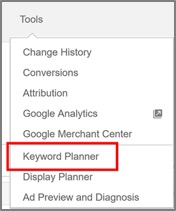
Step 2 – choosing the right tool:
Once you have entered the Keyword Planner, you will be presented with the three different tool options:
These tools will allow you to gain a good insight into what keywords people are searching for, how often they are searching for them, and also how beneficial using these keywords could be to improve your rankings. This information will help you to gain a better understanding of what people want, and will allow you to create more relevant content for your audience.
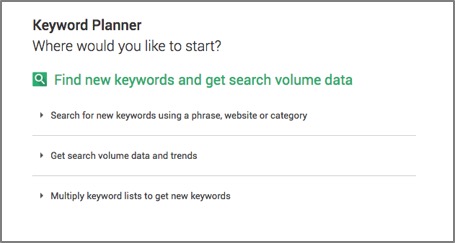
Step 3 – Finding new keywords:
This tool is perfect for finding new keywords and gaining a better understanding of what people are searching for. The first thing you need to do, is come up with a broad keyword that describes your product or service.
For example, let’s say that you work for a company that specialises in SEO.
If you wanted to get a good understanding of what people are searching for and how you can better target your audience, using a keyword like “SEO” would be a good choice.
Enter this keyword into the box labelled “your product or service”
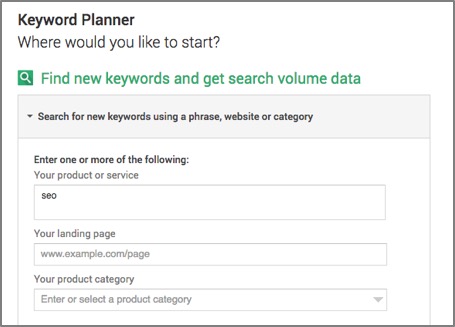
Step 4 – Keyword competition
After you have entered the generic keyword or term in the “search for new keywords” section, Keyword Planner will give you a list of keywords and phrases that people are searching for.
Google Keyword Planner will indicate the keywords as high, medium and low competition. The general understanding is:
• Good monthly search volume + low competition = SEO success
• High monthly search volume + high competition = SEO failure
As you can see, the keyword “backlinks” has a good number of monthly searches and is also low competition, it would therefore be a great keyword to choose; whereas the phrase “seo website” has only a few monthly searches and is high competition, which would be a bad keyword to use.
Once you have decided on a keyword, you can properly optimize the content on your site and start to rank for it.
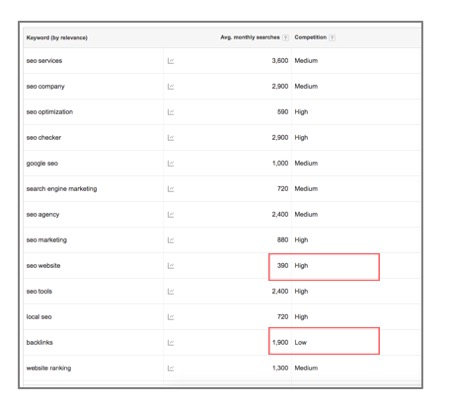
Step 5 – Get search volume data and trends
If you have a specific set of keywords or phrases you want to use to optimize your website, it is beneficial to first check how many searches they get every month, and also how high or low the competition is.
Enter as many product or service related keywords into the “get search volume data” box. For example, let’s say you want to get the search volume data for SEO Manchester and SEM Manchester.
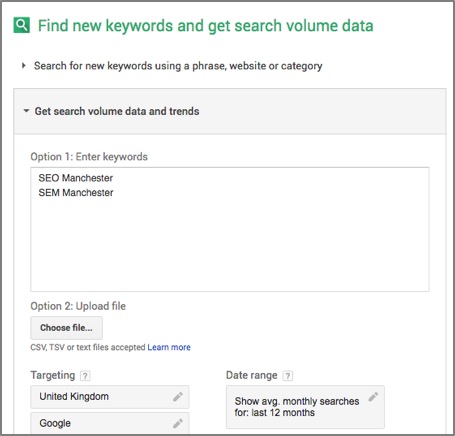
After you have entered all of your keywords, you will be presented with the average monthly searches and monthly trends.
As you can see, SEO Manchester receives much more searches than SEM Manchester, and as it is only medium competition, this could be a good term to rank for.
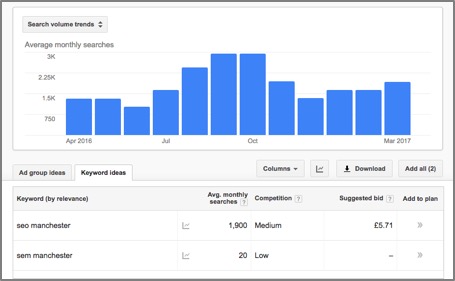
Step 6 – Spotting Trends:
The bar chart in this section reveals the monthly search trends of your chosen keywords. This is a valuable feature as it allows you to see how the interest in keywords changes throughout the year.
As you can see in the data above, in September and October 2016, the term SEO Manchester received 3000 searches, which has fallen to around 1800 searched in March 2017.
To gain a clearer understanding of the keyword searches and how market trends are changing, Keyword Planner allows you to compare searches across different years.
To compare data across different years, simply click the “show average monthly searches for…” box on the left hand side.
As an example, the date ranges “April 2015” to “March 2017” have been chosen.
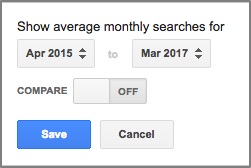
As you can see, the data shows that there has been an increase in searches for “SEO Manchester” over the span of 2 years. From the search trend data, you will be able to make informed decisions on which direction to take your businesses marketing

For example, if your product keyword search is on an incline, you can make an informed decision on how to provide to your customers.
Alternatively, if the data reveals a decline in organic keyword searches around a certain time of the year, you can fully prepare yourself for this and explore alternative marketing methods.
Alternative tools for keyword research:
Although Google is the most used search engine world-wide and champions an astounding 100 billion searches per month, there are several alternative search engine options that people use throughout the world. Bing is the second most popular search engine in the world, with 15.8% of the search market and international search engines provide users with alternatives.
Written by Search Marketing Executive, Hayley Powell.
